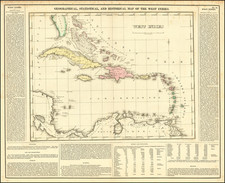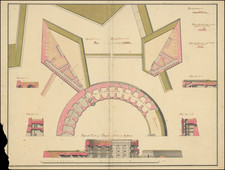Fantasy map showing islands, ships and sea monsters.
Some writers have suggested that this is Columbus's ships sailing through the West Indies, with several sea monsters.
The text translates as follows:
An island is commonly called a piece of land that is surrounded by the sea. Accordingly, any land that is not attached to the large mainland, where one cannot reach with dry feet, is called an island. There are now a great many of these, large and small, as you will see listed in detail with their names. Some have been created since the beginning of the world, and many have arisen over time in the sea, which initially did not exist, such as Delos, Rhodes, Alone, Thera, Sicily, and Therapia. For example, when an earthquake occurs in the sea, it raises an entire land of sand, and when that settles, trees and grass begin to grow there. Sometimes flowing rivers also create lands in the sea by driving a large heap of sand into it. Also, when the sea recedes, a piece of mainland remains, becoming an island. Occasionally, the raging sea breaks off a piece of the mainland, turning it into an island, as has fully happened with Sicily, Cyprus, and Euboea. And here a great wonder of God is felt: that many small islands lie freely in the wide sea, yet are not toppled and drowned by the sea and its great tumultuous waves. For God has set a limit to the sea, says the prophet in the Psalms, beyond which it is forbidden to go. For as by God's command the sea is forcefully and unnaturally held back on one side so that it does not overflow and cover the entire mainland, so too where it meets the mainland it may not go beyond the shore, unless God permits it, as has happened in recent years in the Netherlands, where many parishes have drowned in a day, as I will indicate below in the description of the Netherlands. This could also have been caused by an earthquake, as has happened more elsewhere, especially in Greece, as will be said later.
Sebastian Münster (1488-1552) was a cosmographer and professor of Hebrew who taught at Tübingen, Heidelberg, and Basel. He settled in the latter in 1529 and died there, of plague, in 1552. Münster made himself the center of a large network of scholars from whom he obtained geographic descriptions, maps, and directions.
As a young man, Münster joined the Franciscan order, in which he became a priest. He then studied geography at Tübingen, graduating in 1518. He moved to Basel, where he published a Hebrew grammar, one of the first books in Hebrew published in Germany. In 1521 Münster moved again, to Heidelberg, where he continued to publish Hebrew texts and the first German-produced books in Aramaic. After converting to Protestantism in 1529, he took over the chair of Hebrew at Basel, where he published his main Hebrew work, a two-volume Old Testament with a Latin translation.
Münster published his first known map, a map of Germany, in 1525. Three years later, he released a treatise on sundials. In 1540, he published Geographia universalis vetus et nova, an updated edition of Ptolemy’s Geographia. In addition to the Ptolemaic maps, Münster added 21 modern maps. One of Münster’s innovations was to include one map for each continent, a concept that would influence Ortelius and other early atlas makers. The Geographia was reprinted in 1542, 1545, and 1552.
He is best known for his Cosmographia universalis, first published in 1544 and released in at least 35 editions by 1628. It was the first German-language description of the world and contained 471 woodcuts and 26 maps over six volumes. Many of the maps were taken from the Geographia and modified over time. The Cosmographia was widely used in the sixteenth and seventeenth centuries. The text, woodcuts, and maps all influenced geographical thought for generations.











![Culiacanae, Americae Regionis, Descriptio [with] Hispaniolae, Cubae, Aliarumqe Insualrum Circumiacientium Delineatio](https://storage.googleapis.com/raremaps/img/small/86114.jpg)
![Marine, Pavillions [Nautical Flags]](https://storage.googleapis.com/raremaps/img/small/81796.jpg)
![The Island of Cuba [with] Hayti or Santo Domingo and Porto Rico [with] The Leeward or North Caribee Islands](https://storage.googleapis.com/raremaps/img/small/78673.jpg)
![[First California Wine Making Image] The Vintage In California -- At Work At The Wine Presses](https://storage.googleapis.com/raremaps/img/small/89054.jpg)